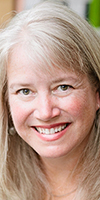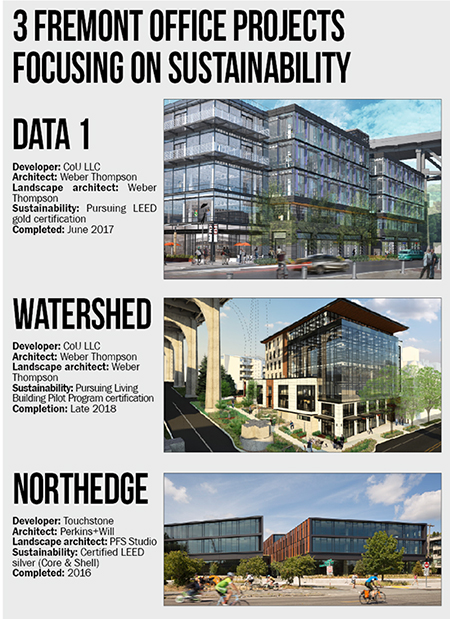|
Subscribe / Renew |
|
|
Contact Us |
|
| ► Subscribe to our Free Weekly Newsletter | |
| home | Welcome, sign in or click here to subscribe. | login |
Real Estate
| |
 |
June 22, 2017
Don’t question the value of green design — bank on it
Weber Thompson

Scott
|
Many of today’s office trends are shaped by the need for increased productivity by employers and the more collaborative needs of millennials, now the largest segment of the workforce. The 40-hour work week has become a 47-hour work week with the majority of managers expecting staff to be available 24-7.
This erosion of the boundary between working primarily at an unchanging desk to one where time or location is blurred by unlimited demands has led to fundamental office space design changes.
Increased productivity demands and extended work time have led to a more varied, flexible work environment — all the better to entice us to stay engaged at work. A healthier workforce is also naturally more productive.
These two goals are driving the increasing adoption of sustainable principles in workplace design supported by programs such as LEED, International Living Future’s Living Building Certification and the newer Well Building Standard.
One microcosm where these trends are being adopted is Seattle’s Fremont neighborhood, rapidly becoming another tech hub as South Lake Union gets built out and perhaps overly identified with one company.
Two newly constructed, fully leased office buildings — NorthEdge, Tableau Software’s new corporate headquarters near Gasworks Park, and Data 1, an office/retail building in Fremont’s commercial heart — showcase some of these trends through their generous daylighting and strong outdoor and neighborhood connections.
A third project, Watershed, under construction this fall, is designed under Seattle’s Living Building Pilot Program. It will meet aggressive energy and water reduction and stormwater re-use goals. It also will vet all building materials for exclusion of toxic chemicals on the International Living Future’s Red List toward Living Building Petal certification.
While some developers question the cost of green building certification, those operating in a competitive marketplace see the practical appeal of sustainable design in attracting tenants to their buildings. Tenants know that sustainable principles like access to natural daylighting and fresh air are keys to employee attraction and retention.
The Fremont neighborhood has a reputation for attracting sustainably focused companies like Brooks Sports, which moved into Stone 34, the pioneering Deep Green Pilot project completed in 2014 by Skanska (and sold to Unico) that set the bar for sustainable design in market rate office in Seattle.

Here are some practical office design trends that don’t break the bank:
• Good design can help reinforce the company culture. Seattle is a competitive hiring environment; attracting top talent is a constant challenge. A cool office space designed with millennials’ working style in mind helps.
Data 1’s glass office space is centered on an interior courtyard that can be used throughout the day as flexible break out spaces or all-company gatherings. NorthEdge’s weathering steel and dark materials palette connect to the industrial history of its site while the stepped building form opens up to the views of Lake Union and downtown Seattle.
• Mixed-use buildings with local retail move office away from inward-focused workspaces to a culture where opportunities to go out to lunch or run errands are within walking distance. Data 1 has five new locally owned restaurants along the street front connected to an outdoor mews on the west end and stepping terraces along Troll Avenue with outdoor seating. NorthEdge’s new restaurant/deli takes advantage of its location next to the Burke-Gilman Trail while extending the restaurant connection from Fremont to Gasworks Park.
• Bikes! Supporting alternative ways of getting to work helps reduce carbon footprint and focus on a healthier lifestyle. Bike clubrooms are becoming a major amenity in new office buildings. A large one like Data 1’s with room for 200 bike stalls and a full locker room acts as a casual place for conversation, catching up on the news, grabbing a cup of coffee and shower — all before heading upstairs to work. Stone 34 and NorthEdge have large locker rooms that are in constant use for outdoor activities ranging from bicycling and running to even kayaking.
• Daylighting and fresh air. It’s not just about reducing energy; we are more productive and creative in a naturally daylit space. Data 1 has floor-to-ceiling glass with almost 60 percent of the interior naturally daylit, and protective exterior shade fins to keep heat gain in check. In addition, operable windows are a must. Being able to open a window for fresh air keeps humans more alert and connected to the outside environment. This sense of individual control over the work environment is highly desired by today’s more mobile workforce.
• Expressed structure. The exposed castellated (notched with openings) steel beams in Data 1 and Watershed are structurally efficient and lightweight, while allowing sprinklers and HVAC systems to run through them, minimizing floor-to-floor height and creating an airy, open space. Their unusual form also makes for a visually interesting ceiling plane filled with changing light and shadow patterns keeping you aware of the time of day.
• Open office plans with quiet breakout spaces and a mix of meeting places. Open offices are great for daylighting, but not so terrific for quiet, focused work. Today’s space plans have everything from rooms for private conversation to open meeting areas with soft seating and great views to more structured conference rooms of varied sizes.
• Roof decks with outdoor rooms and greenery. Rooftops are an opportunity to create equal access to views, provide alternate meeting spaces and host a great staff party. The flexibility of working outside, away from your desk, is highly desired by some employees even in our misty climate. Green roofs are easy on the eye, as well as providers of sustainable stormwater mitigation. NorthEdge’s serenely cascading landscaped terraces, Data 1’s expansive rooftop deck with fire pits, barbecues and greenery, and Watershed’s multilevel decks all provide different places to gather or work outside and feel inspired by urban nature.
• The feature stair. It’s a place to linger with great views or catch-up with a co-worker from a different floor, as well as a way to encourage healthier employees and energy reduction by limiting use of the elevator. Making the stairs highly visible and open to the exterior re-frames them as a vital part of a company’s social connectivity.
• Doing something for the greater good. Recent studies show that employee engagement in social and environmental causes at work leads to much higher job satisfaction. Data 1 and Watershed are filtering and cleaning 500,000 gallons annually of toxic, polluted stormwater from the Aurora Bridge before it goes into Lake Union. The lushly landscaped bio-filtration swales and educational signage on Troll Avenue will engage the building occupants and the neighborhood in the process.
More than ever before, companies are hiring an in-demand, self-empowered workforce that isn’t shy about making its desires known. Thoughtful, sustainable and fundamentally cool offices with attractive amenity spaces are emerging as a valuable aspect to strong recruitment, increased job satisfaction, and more productivity, creativity and retention — all leading to quicker leasing and renewals.
The practical application of sustainable design principles are at the core of current trends, and are becoming the norm rather than the exception. Companies and developers who don’t recognize this may find it harder to fill their spaces.
Kristen Scott is a senior principal at Weber Thompson, where she heads the commercial office architecture design team.
Other Stories:
- New towers create a construction tango in downtown Seattle
- Renters seek buildings that reflect their lifestyles
- Affordable housing gets a boost from impact investors
- Bremerton’s triple treat: affordability, nature, life balance
- When it comes to apartments, one size doesn’t fit all
- Unused building? Consider housing homeless families there
- Westbank tees up 3 big projects in Seattle
- Ready for a revolution in urban transportation?
- Buildings soar skyward as modular frame systems evolve


